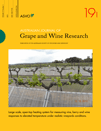View Item
- xmlui.general.dspace_homeCentros Regionales y EEAsCentro Regional Mendoza - San JuanEEA MendozaArtículos científicosxmlui.ArtifactBrowser.ItemViewer.trail
- DSpace Home
- Centros Regionales y EEAs
- Centro Regional Mendoza - San Juan
- EEA Mendoza
- Artículos científicos
- View Item
Effect of extended maceration and ethanol concentration on the extraction and evolution of phenolics, colour components and sensory attributes of Merlot wines
Abstract
Background and Aims: Anecdotal evidence suggests that there may be a synergistic effect of ethanol (EtOH ) and prolonged skin contact on the extraction of certain phenolics that may negatively impact wine sensory properties. The combined effect of extended maceration (EM ) and EtOH concentration was studied during winemaking and bottle ageing.
Methods and Results: The evolution of phenolics and colour components was followed for up to 1 year of bottle
[ver mas...]
Background and Aims: Anecdotal evidence suggests that there may be a synergistic effect of ethanol (EtOH ) and prolonged skin contact on the extraction of certain phenolics that may negatively impact wine sensory properties. The combined effect of extended maceration (EM ) and EtOH concentration was studied during winemaking and bottle ageing.
Methods and Results: The evolution of phenolics and colour components was followed for up to 1 year of bottle ageing. Harvest skins and seeds and those obtained from the pomace after maceration were also analysed. Sensory attributes were studied by Q uantitative F lavour P rofiling. The relationship between the chemical and sensory data was explored with P artial L east S quare R egression. EtOH concentration differing by 1.2% v/v had no effect on tannin and anthocyanin extraction, colour, tannin mean degree of polymerisation, polymeric pigment formation and recovery of anthocyanins and tannins in the pomace after maceration. The maceration length defined the chemical and sensory profile of the wines. The tannin content of wines produced with EM was mainly derived from seed tannins, whereas control wines had a balanced proportion of seed and skin tannins. The anthocyanin concentration was lower in EM wines, whereas polymeric pigments and tannins were predictors of astringency. In control wines, perceived red colour was associated with anthocyanins, vitisins, a* (red component), and small polymeric pigments.
Significance of the Study: Evidence of the nature and interrelation of the chemical and sensory composition of wines obtained with EM is provided. Major chemical features responsible for the sensory properties of wines produced by two contrasting skin contact regimes are identified.
[Cerrar]

Author
Casassa, Luis Federico;
Beaver, Christopher W.;
Mireles, María S.;
Harbertson, James F.;
Fuente
Australian Journal of Grape and Wine Research 19 (1) : 25–39 (February 2013)
Date
2013-02
Editorial
Wiley
ISSN
1755-0238
Formato
pdf
Tipo de documento
artículo
Palabras Claves
Derechos de acceso
Restringido
 Excepto donde se diga explicitamente, este item se publica bajo la siguiente descripción: Creative Commons Attribution-NonCommercial-ShareAlike 2.5 Unported (CC BY-NC-SA 2.5)
Excepto donde se diga explicitamente, este item se publica bajo la siguiente descripción: Creative Commons Attribution-NonCommercial-ShareAlike 2.5 Unported (CC BY-NC-SA 2.5)

